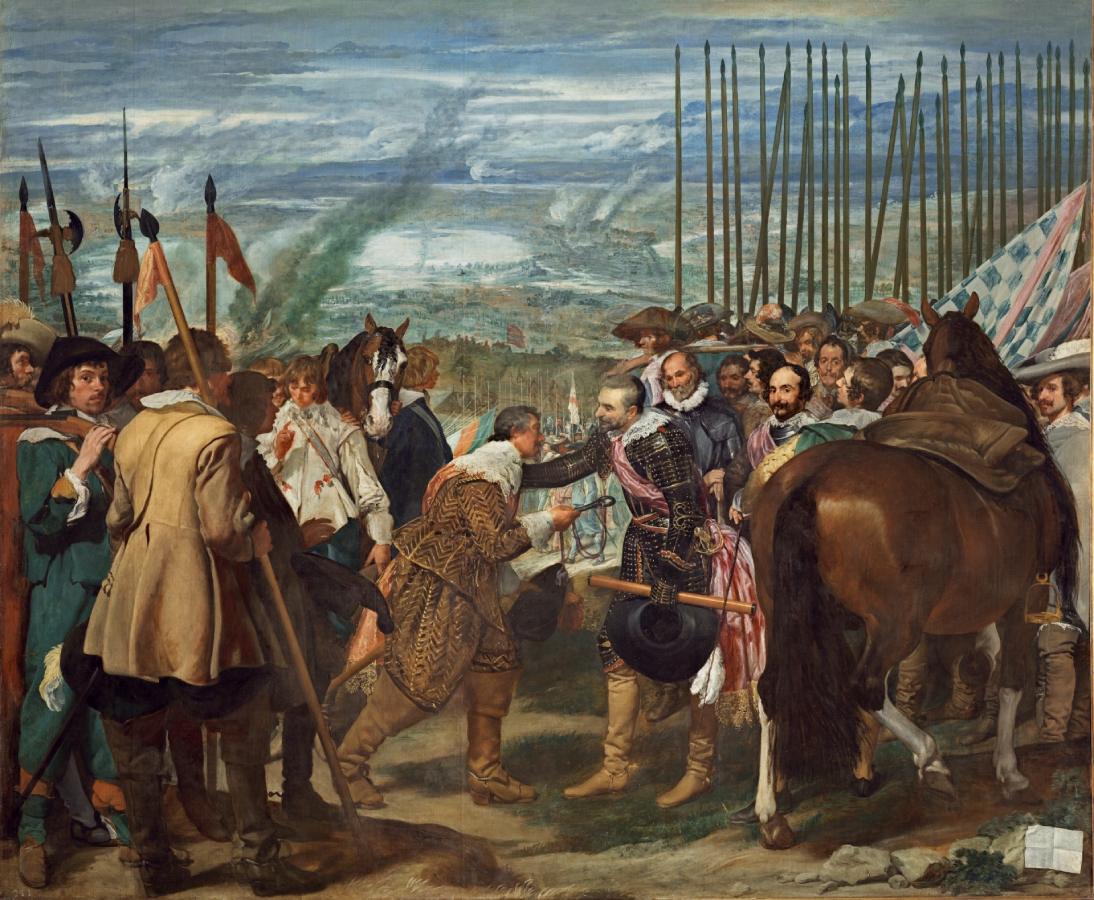Velázquez, Diego (1599-1660)
Las lanzas, o La Rendición de Breda (The Surrender of Breda)
c.1635
Oil on canvas, 307.3 x 371.5 cm
Museo del Prado, Madrid
On June 5, 1625 the Dutch governor of Breda, Justinus van Nassau, surrendered the keys of that city to Ambrosio Spínola, the Genoese general commanding the Spanish tercios (a group of soldiers that included pikemen, swordsmen and musketeers) of Flanders. Breda‘s extraordinary strategic importance made it one of the most disputed cities in the Spanish monarchy’s prolonged war against the United Provinces of the North. Its conquest after a lengthy siege was considered a military accomplishment of the first order, generating a plethora of texts and images intended to exalt the winners. It is therefore not surprising that the decision to decorate the Buen Retiro Palace’s Hall of Realms with a series of paintings narrating the military triumphs of Philip IV‘s reign called for a depiction of what was probably the most resounding victory of all. Nor is it any surprise that Velázquez, who was then the court’s most prestigious painter, was commissioned to paint it. As with his equestrian portrait of Philip IV (P01178), the artist proudly declares his authorship and his stylistic singularity on a sheet of bank paper appearing in the composition’s lower right corner. The painting’s dimensions, the importance of the event it depicts and the significance of the hall where it was to hang all encouraged the painter to put his best efforts into this work, offering proof of his extraordinary faculties. Additional pressure came from the competitive context, as the Hall of Realms included works by the court’s most outstanding artists. Velázquez met the challenge with a masterpiece that reveals not only his extraordinary descriptive gifts and mastery of aerial perspective, but also his narrative skills and his capacity to place all of a painting’s elements at the service of a specific content.
As numerous scholars have pointed out, this is no ordinary pictorial celebration of victory or martial ideals -its smoking background speaks clearly of destruction, war and death- but it does concentrate our attention on the foreground, where the triumphant general receives the key from his vanquished foe with an attitude closely resembling affection, in a gesture that seems more like the announcement of impending peace than that of war’s end. The entire composition is designed to emphasize this gesture, and both the group of Dutch soldiers (at the left) and the Spaniards serve to frame, accompany and shelter this principal motif, drawing our attention directly to it. The two generals constitute an image that conveys the message with extraordinary efficiency, and historians have related it to extremely varied sources and antecedents from both profane symbolism (Andrea Alciato’s Emblematum liber) and Christian iconography. In fact, Velázquez‘s interpretation of the battle has very precise precedents: both Hermann Hugo, in his historical treatise, Obsidio bredana, and Pedro Calderón de la Barca, in one of his plays, approached the subject in a similar way, insisting on the magnanimity of General Spinola and his army, who treated their enemy with the respect they deserved as worthy rivals, rather than the disdain meted out to the vanquished. Indeed, Calderón‘s The Seige of Breda, from 1635, describes the very event depicted in the painting in much the same terms, as an almost friendly encounter. A very similar content is also transmitted by Juan Bautista Maíno’s The Recovery of Bahia in 1625 (P885). Velázquez‘s genius lies in having discovered the ideal formula for transmitting that content, which he did by eliminating all rhetoric and drawing instead on the most straightforward, and thus the most efficient means: the simple gesture of the two generals is enough to transmit a theory of State and a view of history. Generically, this painting can be dated between 1634 and 1635, as the decoration of the Hall of Realms is known to have begun in 1634 and was finished by spring, 1635. (Museo Nacional del Prado, El Palacio del Rey Planeta: Felipe IV y el Buen Retiro, Madrid, Museo Nacional del Prado, 2005, p.132-133)
See also:
• Breda (Netherlands)
